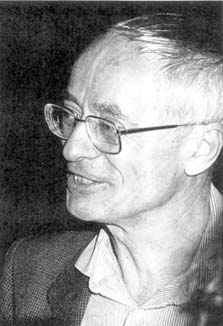


 تاريخ الرياضيات
تاريخ الرياضيات
 الرياضيات في الحضارات المختلفة
الرياضيات في الحضارات المختلفة 
 الرياضيات المتقطعة
الرياضيات المتقطعة
 الجبر
الجبر
 الهندسة
الهندسة 
 المعادلات التفاضلية و التكاملية
المعادلات التفاضلية و التكاملية 
 التحليل
التحليل
 علماء الرياضيات
علماء الرياضيات |
Read More
Date: 21-2-2018
Date: 20-2-2018
Date: 21-2-2018
|
Born: 15 September 1926 in Bages, France

Jean-Pierre Serre was educated at the Lycée de Nimes and then the École Normale Supérieure in Paris from 1945 to 1948. Serre was awarded his doctorate from the Sorbonne in 1951. From 1948 to 1954 he held positions at the Centre National de la Recherche Scientifique in Paris.
In 1954 Serre went to the University of Nancy where he worked until 1956. From 1956 he held the chair of Algebra and Geometry in the Collège de France until he retired in 1994 when he became an honorary professor. His permanent position in the Collège de France allowed Serre to spend quite a lot of time making research visits. In particular he spent time at the Institute for Advanced Study at Princeton and at Harvard University.
Serre's early work was on spectral sequences. A spectral sequence is an algebraic construction like an exact sequence, but more difficult to describe. Serre did not invent spectral sequences, these were invented by the French mathematician Jean Leray. However, in 1951, Serre applied spectral sequences to the study of the relations between the homology groups of fibre, total space and base space in a fibration. This enabled him to discover fundamental connections between the homology groups and homotopy groups of a space and to prove important results on the homotopy groups of spheres.
Serre's work led to topologists realising the importance of spectral sequences. The Serre spectral sequence provided a tool to work effectively with the homology of fiberings.
For this work on spectral sequences and his work developing complex variable theory in terms of sheaves, Serre was awarded a Fields Medal at the International Congress of Mathematicians in 1954.
Serre's theorem led to rapid progress not only in homotopy theory but in algebraic topology and homological algebra in general.
Over many years Serre has published many highly influential texts covering a wide range of mathematics. Among these texts, which show the topics Serre has worked on, are Homologie singulière des espaces fibrés (1951), Faisceaux algébriques cohérents (1955), Groupes d'algébriques et corps de classes (1959),Corps locaux (1962), Cohomologie galoisienne (1964), Abelian l-adic representations (1968), Cours d'arithmétique (1970), Représentations linéaires des groupes finis (1971), Arbres, amalgames, SL2 (1977), Lectures on the Mordell-Weil theorem (1989) and Topics in Galois theory (1992).
These books are outstanding and led to Serre being honoured. In 1995 he was awarded the Steele Prize for mathematical exposition and the citation for the award reads [2]:-
It is difficult to decide on a single work by a mathematician of Jean-Pierre Serre's stature which is most deserving of the Steele Prize. Any one of Serre's numerous other books might have served as the basis of this award. Each of his books is beautifully written, with a great deal of original material by the author, and everything smoothly polished. It would be hard to make any significant improvement on his expositions; many are the everyday standard references in their areas, both for working mathematicians and graduate students. Serre brings his whole mathematical personality to bear on the material of these books; they are alive with the breadth of real mathematics and are an example to all of how to write for effect, clarity, and impact.
The references [4] and [5] provide a fascinating view of Serre's views on some aspects of his career up to 1985:-
Presently, the topic which amuses me most is counting points on algebraic curves over finite fields. It is a kind of applied mathematics: you try to use any tool in algebraic geometry and number theory that you know of, ... and you don't quite succeed!
The interview in [4] and [5] also provides a chance to examine Serre's views on mathematics.
Serre has received numerous awards. In addition to the Fields Medal in 1954 he was elected a Fellow of the Royal Society of London in 1974. He has also been made an Officer Légion d'Honneur and Commander Ordre National du Mérite. He has been elected to many national academies in addition to the Royal Society, in particular the academies of France, Sweden, United States and the Netherlands. He was awarded the Prix Gaston Julia in 1970, the Balzan Prize in 1985, the Steele Prize, described above, from the American Mathematical Society in 1995 and the Wolf Prize in 2000. He has been awarded honorary degrees from the University of Cambridge in 1978, the University of Stockholm in 1980, the University of Glasgow in 1983, the University of Harvard in 1998 and the University of Oslo in 2002. In 2003 he was awarded the first Abel Prize by the Norwegian Academy of Science and Letters.
Articles:



|
|
|
|
دخلت غرفة فنسيت ماذا تريد من داخلها.. خبير يفسر الحالة
|
|
|
|
|
|
|
ثورة طبية.. ابتكار أصغر جهاز لتنظيم ضربات القلب في العالم
|
|
|
|
|
|
|
العتبة العباسية المقدسة تقدم دعوة إلى كلية مزايا الجامعة للمشاركة في حفل التخرج المركزي الخامس
|
|
|